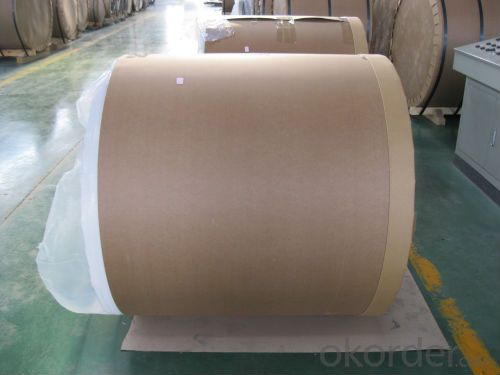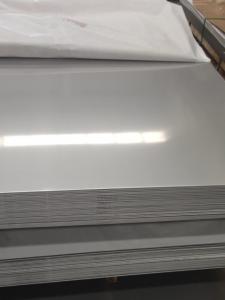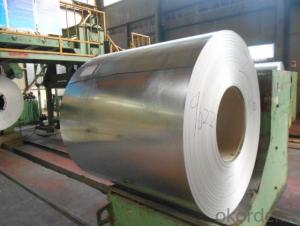Stainless Steel Cold Rolled Steel Sheet With Best Price In Warehouse
- Loading Port:
- Shanghai
- Payment Terms:
- TT or LC
- Min Order Qty:
- 6 m.t.
- Supply Capability:
- 5000 m.t./month
OKorder Service Pledge
OKorder Financial Service
You Might Also Like
1.Structure of Product Description
Cold rolled and hot rolled Stainless steel sheet are widely used in the field of construction field and decoration field, etc. There are many different grades, such as: 200 series, 300 series, 400 series, 900series, etc. The detailed grade are as follows: 201, 202, 301, 304, 316, 410, 420, 430, etc, or according to our client's requirement. if you are interested in it, please kindly show us your detailed inquiry, so that i can quote you price later.
2. Main features of the product
b. Frist-Class Service.
c. Shortest service.
3. Image.

4. Product detailed sizes:
1220mm*2440mm, 1250mm*2500mm,1500mm*3000mm, etc.
5. FAQ:
What is the quality standard?
---Usually our standard is GB3880-2006 or else.
What is the width range?
What is the MOQ for your products yet?
---Normally it is around 3 tons/each size.
How many tons did you export in one year?
---Normally it is around 9000 tons totally.
Where is your client from?
---Normally it is from Japan, USA, ENGLISH, SINGAPORE, ETC.
What is your mainly products?
---Normally they are stainless steel sheet, stainless steel coil, stainless steel checkered sheet, stainless steel mirror finished sheet, color coated stainless steel sheet, etc.
- Q:How do you remove rust or corrosion from stainless steel sheets?
- In order to eliminate rust or corrosion from stainless steel sheets, the following steps can be followed: 1. Initiate the process by cleansing the surface of the stainless steel sheet using a mild detergent and warm water. This will eradicate any dirt or grease that may potentially impede the rust removal procedure. 2. Subsequently, ensure the sheet is thoroughly dried to prevent any further water damage and to guarantee the effectiveness of the rust removal process. 3. Proceed by utilizing a non-abrasive scrubbing pad or a soft cloth to apply a stainless steel cleaner or a homemade solution comprising equal parts vinegar and water. Gently rub the affected area in the direction of the grain of the stainless steel. 4. If the rust or corrosion persists, experiment with a paste formed from baking soda and water or a mixture of cream of tartar and water. Apply this paste to the affected region and allow it to sit for approximately 15 minutes. Then, delicately scrub the area with a soft cloth or a non-abrasive scrubbing pad. 5. If the aforementioned methods do not completely eliminate the rust or corrosion, consider using a commercial rust remover specifically formulated for stainless steel. Make sure to adhere to the manufacturer's instructions and adopt suitable safety precautions. 6. Once the rust or corrosion has been eradicated, rinse the stainless steel sheet thoroughly with clean water and completely dry it to prevent any water spots or further damage. 7. To prevent future rust or corrosion, it is advisable to regularly clean and maintain stainless steel surfaces using non-abrasive cleaners and avoiding harsh chemicals or abrasive materials. Always remember to conduct a test of any cleaning solution or rust remover on a small and inconspicuous area of the stainless steel sheet prior to applying it to the entire surface, to ensure it does not cause any damage or discoloration.
- Q:304 how can the water stain on the surface of stainless steel plate be formed?
- If you want to scrub the proposal as soon as possible processing, water Jiyue long more difficult to wear off, if it is ferrite, also easy to rust.
- Q:What are the different grades of stainless steel sheets?
- Stainless steel sheets are available in various grades, each offering different properties and characteristics. The most commonly used grades of stainless steel sheets include: 1. 304 Stainless Steel: This is the most widely used grade and is known for its excellent corrosion resistance, good formability, and high strength. It is commonly used in food processing equipment, kitchen appliances, and chemical containers. 2. 316 Stainless Steel: This grade has even better corrosion resistance than 304 stainless steel and is often used in marine environments or applications involving exposure to corrosive chemicals. It also has good welding and forming properties. 3. 430 Stainless Steel: This is a ferritic grade that is commonly used in applications requiring good corrosion resistance and moderate strength. It is often used in automotive trim, kitchen equipment, and decorative applications. 4. 410 Stainless Steel: This grade is a martensitic stainless steel that offers high strength and hardness. It is commonly used in applications where wear resistance and corrosion resistance are required, such as cutlery, surgical instruments, and industrial equipment. 5. 201 Stainless Steel: This is a low-nickel grade that offers good formability and moderate corrosion resistance. It is commonly used in decorative applications, such as architectural trim, appliances, and furniture. These are just a few examples of the different grades of stainless steel sheets available. The choice of grade depends on the specific application and the desired properties of the material, such as corrosion resistance, strength, formability, and cost.
- Q:What is the fire resistance rating of stainless steel sheets?
- The fire resistance rating of stainless steel sheets varies depending on their thickness and grade, but generally, stainless steel exhibits good fire resistance properties due to its high melting point and low thermal conductivity.
- Q:How do you attach stainless steel sheets to a wall?
- To attach stainless steel sheets to a wall, you can use a combination of adhesive and mechanical fasteners. First, ensure that the wall is clean and free from any debris or grease. Apply a strong construction adhesive to the back of the stainless steel sheet, spreading it evenly across the surface. Then, press the sheet firmly against the wall and hold it in place for a few minutes to allow the adhesive to bond. Additionally, use mechanical fasteners such as screws or nails to secure the stainless steel sheet to the wall, placing them along the edges and in the center of the sheet for added support and stability.
- Q:Can stainless steel sheets be used for bridge construction?
- Yes, stainless steel sheets can be used for bridge construction. Stainless steel is a highly durable and corrosion-resistant material, making it an excellent choice for bridge construction where exposure to harsh environmental conditions is a concern. Stainless steel sheets offer structural strength, stability, and long-term reliability, making them suitable for various bridge components such as beams, girders, and decking. Additionally, stainless steel's aesthetic appeal and low maintenance requirements further contribute to its suitability for bridge construction projects.
- Q:What are the different types of stainless steel sheet embossing patterns available?
- There are several different types of stainless steel sheet embossing patterns available. Some of the most common patterns include: 1. Diamond: This pattern features a series of diamond-shaped indentations evenly spaced across the surface of the sheet. It creates a visually appealing and textured appearance. 2. Linen: The linen pattern resembles the texture of linen fabric, with a series of parallel lines running in one direction and perpendicular lines intersecting them. It adds a subtle and sophisticated look to stainless steel sheets. 3. Stucco: The stucco pattern creates a raised, pebble-like texture on the surface of the sheet. It is commonly used in architectural applications to add visual interest and a tactile feel. 4. Leather: This pattern replicates the texture of leather, with a series of irregular lines and indentations. It provides a unique and luxurious appearance to stainless steel sheets. 5. Hammered: The hammered pattern features a series of irregular indentations that resemble the marks made by a hammer. It adds a rustic and handcrafted look to stainless steel sheets. 6. Checkerboard: This pattern consists of a grid of squares, with alternating squares raised or recessed. It creates a classic and geometric design on stainless steel sheets. 7. Wave: The wave pattern features a series of curved lines that resemble ocean waves. It adds a dynamic and flowing look to stainless steel sheets. These are just a few examples of the many different types of stainless steel sheet embossing patterns available. Each pattern can be customized in terms of size, depth, and spacing to suit specific design preferences and applications.
- Q:The difference between 304J1 stainless steel plate and 304 stainless steel plate
- The price is lower, the deep processing performance is better.304J1 stainless steel is a copper containing material of 304 stainless steel. It is mainly used for deep processing, and also belongs to the series of nickel. By the Japanese on the basis of the successful development of American Standard 304.
- Q:Are stainless steel sheets suitable for roofing?
- Yes, stainless steel sheets are suitable for roofing. They have excellent durability, corrosion resistance, and can withstand extreme weather conditions. Additionally, their sleek appearance adds aesthetic value to any building.
- Q:How do you remove adhesive residue from stainless steel sheets?
- To effectively eliminate adhesive residue from stainless steel sheets, the following steps can be followed: 1. Commence by delicately scraping off as much of the residue as possible using a plastic scraper or your fingernail. Exercise caution to avoid scratching the stainless steel surface. 2. Subsequently, moisten a soft cloth with warm water and a mild detergent or dish soap. Employ gentle circular motions to scrub the adhesive residue. Refrain from using abrasive cleaners or scrub brushes as they have the potential to harm the stainless steel finish. 3. If the adhesive residue persists, consider utilizing a non-abrasive cleaner specifically designed for stainless steel. Apply a small quantity of the cleaner to a soft cloth and gently rub the residue until it detaches. 4. In the case of tenacious adhesive residue, a paste can be concocted by combining baking soda and water. Apply the paste to the affected area and allow it to sit for a few minutes. Subsequently, utilize a soft cloth to gently scrub the residue in circular motions. 5. Thoroughly rinse the stainless steel sheet with warm water to eliminate any remaining residue or cleaner. 6. Finally, employ a clean, soft cloth to dry the surface, thereby preventing water spots and streaks. It is important to always test any cleaning method or product on a small, inconspicuous area of the stainless steel sheet prior to applying it to the entire surface. This precautionary measure ensures that no damage or discoloration occurs.
1. Manufacturer Overview |
|
|---|---|
| Location | |
| Year Established | |
| Annual Output Value | |
| Main Markets | |
| Company Certifications | |
2. Manufacturer Certificates |
|
|---|---|
| a) Certification Name | |
| Range | |
| Reference | |
| Validity Period | |
3. Manufacturer Capability |
|
|---|---|
| a)Trade Capacity | |
| Nearest Port | |
| Export Percentage | |
| No.of Employees in Trade Department | |
| Language Spoken: | |
| b)Factory Information | |
| Factory Size: | |
| No. of Production Lines | |
| Contract Manufacturing | |
| Product Price Range | |
Send your message to us
Stainless Steel Cold Rolled Steel Sheet With Best Price In Warehouse
- Loading Port:
- Shanghai
- Payment Terms:
- TT or LC
- Min Order Qty:
- 6 m.t.
- Supply Capability:
- 5000 m.t./month
OKorder Service Pledge
OKorder Financial Service
Similar products
New products
Hot products
Hot Searches
Related keywords






























